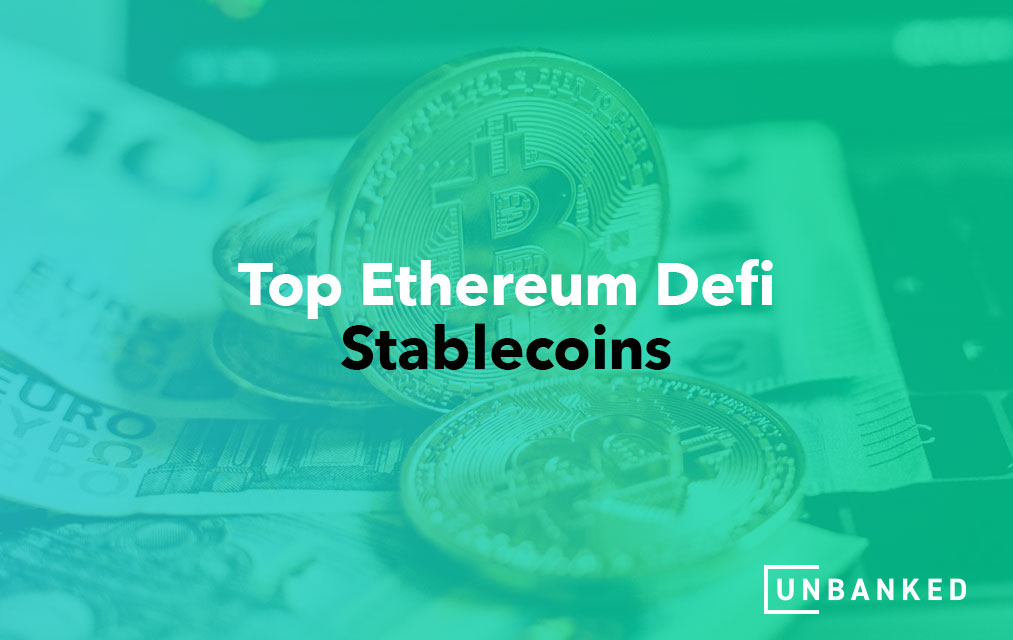Top Five Ethereum Defi Stablecoins
Decentralized Finance, or DeFi, is one of the latest innovations that has emerged out of the blockchain-powered, decentralized economy. Primarily developed on the Ethereum chain, DeFi apps provide users with classical banking services but in a decentralized, borderless way, thus enabling anyone around the world with an internet connection to use those services. The rise of DeFi apps allow users to borrow, lend, invest, trade and make payments effortlessly without the need for a financial institution as an intermediary.
From commerce to payments, to banking and lending, to managing investment and asset tokenization, DeFi technology has begun to reach all major areas of the global financial infrastructure. Today, the DeFi market has experienced substantial growth and is now a $14 billion market, according to metric site Coingecko.
A particularly exciting area of open decentralized finance growth in last year was the diverse stablecoin space. 2019 saw the announcement of JPMorgan Coin and Facebook’s Libra, while projects like Tether and DAI gained further momentum––their combined market cap is over $13 billion as of this writing, more than triple what they were a year ago.

The exponential growth of stablecoins can be additionally explained by their diversity, which has made decentralized financial instruments more accessible and offer its users a chance to gain long-term benefits. The value offered by stablecoins has turned them into a great investment opportunity and has begun to gather considerable momentum. In this blog post, we cover the top 5 stablecoins currently making waves in the growing Ethereum’s decentralized finance sphere.
Related: Changing the Crypto Narrative
Stablecoins & DeFi
The stablecoin monetary base hit over $65 billion in Q1, and it continues to increase at an incredible pace, according to this study by Messari. In addition, stablecoins facilitated $1 trillion in transaction volume, which was more than the prior four quarters combined. The largest gainer was USDC, which increased its market share by 17%.”
Global stablecoins allow investors to earn a return on their crypto assets while avoiding the negative impacts of market volatility in the DeFi market.
If an investor invests ETH in the Compound protocol to earn interest, there’s a chance that a decline in the price of ETH may wipe out all of the earnings, leaving the investor with a loss. However, in the same situation, if that investor chose a stablecoin, the underlying asset’s value would stay stable, and the yield would not be influenced by the crypto market’s volatility.
Investors seeking a higher rate of return than typical fixed-income assets can digitize their funds and earn above-average returns in the DeFi market.
Stablecoins are becoming increasingly valuable assets in the DeFi loan markets, which is unsurprising. With loan rates ranging from 0.15 percent to 11.82, USDC and other stablecoins have established themselves as some very popular lending assets.
Tether (USDT)
A giant of DeFi, Tether is considered to be the most appreciative stablecoin since its launch in 2014, given its impressive market cap and trade volume. As per research by TheBlockfi, the USDT/ETH trading pair dominates the stablecoin space with 62% transactions. Tether alone is responsible for 94% of stablecoin trading volume, which is on par with Bitcoin in terms of market domination. At the time of writing, Coingecko shows USDT daily volume is higher than that of BTC, and is at second place on Coingecko’s best-performing assets ranking.
This is unsurprising onsidering the fact that Tether raised almost 89% of the total stablecoin supply by the end of the first quarter of 2020 and even managed to outplay biggies like Ripple and Bitcoin Cash.
It’s noteworthy that over 77% of USDT coins represent Tether’s market share on the Ethereum blockchain, and it’s just the beginning of the DeFi boom. With its recent cooperation with AAVE to borrow and lend USDT tokens as well as use them as collateral, Tether is only going to grow in the coming years.
Maker’s Dai (DAI)
Launched in 2017 by MakerDAO, DAI is pegged to the US dollar and issued on the basis of a complex system of oracles and over-collateralized loans. DAI’s value is backed by Ethereum, BAT, Wrapped Bitcoin and USD Coin, with USD Coin and Wrapped Bitcoin improving DAI’s liquidity and price stability while reducing the vulnerability of Market Protocol.
Billed as “the world’s first unbiased” stablecoin, DAI can serve as a medium of exchange, a unit of account and a store of value. This stable asset empowers a large spectrum of banking applications and activities with strong resilience against the cryptocurrencies’ volatility. Today, DAI has been used by many DeFi protocols, which has led to a rapid 355% surge in transaction volume in the first quarter of 2020.
USD Coin (USDC)
Another gaining speed in the DeFi space is Coinbase’s USD Coin. The first quarter of 2020 observed a decline in USDC’s market capitalization, however; the coin has gained significant growth since mid-March. At the time of writing, USDC holds a sustainable market cap of $1 billion, thus making it the second largest stable asset. At the same time, the USDC coin trails Tether coin with 13% of the total coins locked into Ethereum blockchain, the result of its importance in Compound and AAVE protocols.
In fact, Coinbase’s Coin has the third lowest NVT rate since its usage is moderate compared to overall network value. The coin is pegged and backed 1:1 to the US Dollar to maintain liquidity in the stablecoin market. Moreover, Coinbase performs regular monthly audits to maintain the ratio.
Paxos Standard (PAX)
Built on top of the Ethereum open-blockchain network, Paxos Standard is an ERC-20 token that aims to bring price stability to cryptocurrencies through the use of its stablecoin. The coin was established after the Paxos team noticed the opportunity in the infamous Tether controversy and made an extra effort to be as transparent as possible.
The coin is fully collateralized 1:1 by the US dollar, and is approved and regulated by the New York State Department of Financial Services. Moreover, Paxos offers the benefits of crypto-assets such as decentralized accounting and immutability. Since the coin is fully collateralized by dollars, Paxos offers a liquid and digital alternative to cash that is fully redeemable and available round the clock for instantaneous transaction settlement.
True USD (TUSD)
TrueUSD is a fully collateralized, legally protected and transparently verified ERC20 stablecoin. Introduced in early 2018, TrueUSD’s US dollar holdings are distributed in multiple bank accounts that belong to various trust parties, who publish the collateralized holding daily and conduct monthly audits. The stablecoin uses multiple escrow accounts to offer legal protections to token-holders against misappropriation.
The coin was the first regulated stablecoin fully backed by the U.S. dollar. It works through the use of smart contracts on the Ethereum open-blockchain network, then uses those smart contracts to issue and redeem a tokenized version of the U.S. dollar. Since the token creates a natural arbitrage opportunity in the market, its value is automatically pegged to the dollar.
Related: Ethereum vs. Bitcoin
DeFi on Ethereum
The Ethereum blockchain, the world’s top smart contract platform, is used by the great majority of DeFi protocols. There are presently over 200 DeFi apps on Ethereum.
Decentralized banking protocols erupted in the summer of 2020 on Ethereum, attracting large amounts of attention and money. But before we go into particular protocols, let’s take a look at two elements of DeFi that have generated so much attention.
Yield Farming
Yield farming is arguably the most talked-about topic in today’s DeFi sector. Yield farming is the practice of investing crypto assets in DeFi protocols in order to maximize profits. Yield farming may take several forms, the most popular of which is putting money into high-yielding lending programs.
Liquidity Mining
Liquidity mining was the most recent yield farming practice to emerge during “DeFi Summer.” Liquidity mining refers to the process of supplying liquidity to DeFi protocols like decentralized exchanges in exchange for freshly created protocol tokens.
Because these tokens may be exchanged on the secondary market, an incentive structure is formed in which investors can earn significant returns in the form of protocol tokens by investing as much cash as possible in a protocol.
DeFi: Today, Tomorrow, and Beyond
Decentralized finance began in 2009 with the introduction of Bitcoin, which allowed individuals to keep and move funds totally decentralized across the internet for the first time. Decentralized, smart contract-powered apps on top of a blockchain that try to imitate traditional financial services are now referred to as DeFi.
Decentralized exchanges on the Ethereum network were the first decentralized finance apps. Smart contracts are used by an exchange to allow investors to exchange ETH to ERC20 tokens and vice versa.
The construction of yield-generation savings protocols was the next phase in the DeFi movement in late 2018. Several new loan and borrowing apps, as well as new forms of decentralized financial applications, appeared during the next twelve months.
DeFi Today
As of April 20th, 2021, the decentralized finance sector has evolved into a multi-billion-dollar business, with over $56 billion invested in DeFi protocols. In Q1 2021, DappRadar reported that there were over 458,000 daily unique active wallets across all chains, representing a 639 percent YoY increase.
Three popular use cases for DeFi are:
- Lending and borrowing
- Derivatives trading
- Digital asset trading
Also, DeFi users can:
- Trade digital assets on margin
- Invest in baskets of digital assets
- Hedge digital asset exposure
- Bet on trustless prediction markets
- Take out an insurance policy
As the DeFi business expands, new protocols are developed to meet new market demands and to develop innovative, new financial contract types.
DeFi Tomorrow
The DeFi market is presently a battleground for seasoned crypto investors who know how to work with smart contracts and handle several digital assets.
The ordinary retail investor has yet to access the DeFi sector due to the significant expertise barriers. That is likely to alter in the future. The DeFi market of the future will provide everybody in the world access to a decentralized, global financial marketplace that offers all of the same services that traditional financial institutions do.
Someone running a market stall in India, for example, will be able to borrow cash via a decentralized lending protocol using their smartphone at competitive rates. On the other hand, a merchant in Kenya concerned about inflation may invest in a yield-generating protocol that generates a greater APR than the current inflation rate. Some of the capabilities we hope to see in DeFi in the future are already available due to market-leading applications.
DeFi Challenges
Although the DeFi movement is perhaps one of the most promising in the financial technology sector, it is not without its obstacles.
Currently, Ethereum is used by the great majority of DeFi protocols. Unfortunately, the Ethereum ledger is unable to handle the enormous volume of transactions being processed as DApp usage skyrocketed in 2020, owing mostly to the surge in DeFi. As a result, transaction fees and transaction processing times on the Ethereum network have skyrocketed, hitting their highest levels since 2017.
For DeFi users, this means that absolute returns are reduced due to the high expenses required to enter and exit DeFi protocols.
While the Ethereum development community is working on future network updates to solve these vulnerabilities, DeFi’s future is likely to be multi-chain. The Ethereum blockchain network will not be the only one to host DeFi protocols.
As a result, global stablecoins will also likely become multi-chain digital currencies. USDC has already taken that step by directly integrating with the blockchains of Algorand, Solana, and Stellar, with ambitions to expand to many more.
In Conclusion
Despite the impact of Covid-19 on the world economy, digital currencies, stablecoins in particular, observed significant growth in the DeFi space in 2020. By combining the best of both crypto and fiat, Ethereum-based DeFi stablecoins will add to digital currency adoption by increasing transparency and decreasing transaction risk. Tether, DAI, USDC and TUSD are all supported by Blockcard. You can deposit these and other digital assets into your Blockcard account to give your crypto immediate spending power.
Interested in investing in DeFi stablecoins? Get started with our Unbanked BlockCard today!
Related: 5 Steps to Earn Free Crypto
The contents of this blog should not be taken as investment advice. Always do your own research or consult a professional before buying, selling or trading any digital asset.










